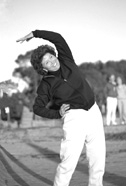

 A
balanced diet and regular physical activity are the building blocks of
good health. Poor eating habits and too little physical activity can lead
to overweight and related health problems. By eating right and being active,
you can stay at or reach a healthy weight. Do it for yourself and your
family!
A
balanced diet and regular physical activity are the building blocks of
good health. Poor eating habits and too little physical activity can lead
to overweight and related health problems. By eating right and being active,
you can stay at or reach a healthy weight. Do it for yourself and your
family!
What is a healthy diet?
 The
basis of a healthy diet is eating a wide variety of foods. Every day,
you should try to eat:*
The
basis of a healthy diet is eating a wide variety of foods. Every day,
you should try to eat:*
-
6 to 11 servings of bread, cereal, rice, or pasta. One serving equals one slice of bread, about 1 cup of ready-to-eat cereal, or 1/2 cup cooked cereal, rice, or pasta.
-
3 to 5 servings of vegetables. One serving equals 1 cup of raw leafy vegetables, or 1/2 cup of other vegetables, cooked or raw.
-
2 to 4 servings of fruit. One serving equals one medium apple, banana, or orange; 1/2 cup of chopped, cooked, or canned fruit; or 3/4 cup of fruit juice.
-
2 to 3 servings of milk, yogurt, or cheese. One serving equals 1 cup of milk or yogurt, 1 1/2 ounces of natural cheese (such as Cheddar), or 2 ounces of processed cheese (such as American). Choose low-fat or fat-free products most often.
-
2 to 3 servings of meat, poultry, fish, dry beans, eggs, or nuts. One serving equals 2 to 3 ounces of cooked lean meat, poultry without skin, or fish. You should eat no more than 5 to 7 ounces per day. One half cup of cooked dry beans, one egg, or 1/2 cup of tofu counts as 1 ounce of meat. Two tablespoons of peanut butter or 1/3 cup of nuts counts as 1 ounce of lean meat.
The larger number of servings is for active men. Eat a smaller number of servings if you are a woman, inactive, or trying to lose weight.
* Servings and serving sizes are from the U.S. Department of Agriculture/Department of Health and Human Services Food Guide Pyramid
You can not always measure your food. Here are some ways to help you estimate serving sizes.
 1/2
cup of rice or pasta = size of ice cream scoop
1/2
cup of rice or pasta = size of ice cream scoop
 1
cup of salad greens = size of a baseball
1
cup of salad greens = size of a baseball
 1/2
cup of chopped fruit or vegetables = size of a lightbulb
1/2
cup of chopped fruit or vegetables = size of a lightbulb
 1
1/2 ounces of cheese = size of four dice
1
1/2 ounces of cheese = size of four dice
 3
ounces of meat or fish = size of a deck of cards or cassette tape
3
ounces of meat or fish = size of a deck of cards or cassette tape
Tips for healthy eating
- Eat breakfast every day. People who eat breakfast are less likely to overeat later in the day. Breakfast also gives you energy and helps you think and learn.
- Choose whole grains more often. Try whole wheat breads and pastas, oatmeal, brown rice, or bulgur.
- Select a mix of colorful vegetables each day. Different colored vegetables provide different nutrients. Choose dark, leafy greens such as kale, collards, and mustard greens, and reds and oranges such as carrots, sweet potatoes, red peppers, and tomatoes.
- Choose fresh or canned fruit more often than fruit juice. Fruit juice has little or no fiber.
- Use fats and oils sparingly. Olive, canola, and peanut oils, avocados, nuts and nut butters, olives, and fish provide heart-healthy fat as well as vitamins and minerals.
- Eat sweets sparingly. Limit foods and beverages that are high in added sugars.
- Eat three meals every day instead of skipping meals or eating a snack instead of a meal.
- Have low-fat, low-sugar snacks on hand at home, at work, or on the go, to combat hunger and prevent overeating.
Quick
breakfast ideas
- low-fat yogurt sprinkled with low-fat granola
- oatmeal with low-fat or fat-free milk, or soy-based beverage
- whole wheat toast with thin spread of peanut butter
- fruit smoothie made with frozen fruit, low-fat yogurt, and juice
- low-sugar cereal with soy-based beverage
Easy snack ideas
- low-fat
or fat-free yogurt

- rice cakes
- fresh or canned fruits
- sliced vegetables or baby carrots
- dried fruit and nut mix (no more than a small handful)
- air-popped popcorn sprinkled with garlic powder or other spices
- low-sugar cereal

What is a healthy weight?
Body mass index (BMI) is one way to tell whether you are at a healthy weight, overweight, or obese. It measures your weight in relation to your height. A BMI of 18.5 to 24.9 is in the healthy range. In the chart below, find your height in the left-hand column and move across the row to find your weight. If you are in the overweight or obese range on the chart, you are more likely to have certain health problems.
*Without shoes **Without clothes
Another way to find out if you are at risk for health problems caused by overweight and obesity is to measure your waist. If you are a woman and your waist is more than 35 inches, or if you are a man and your waist is more than 40 inches, your risk of disease is higher.
What are the health risks of being overweight?
Extra weight can put you at higher risk for:
-
type 2 diabetes (high blood sugar)
-
high blood pressure
-
heart disease and stroke
-
some types of cancer
-
sleep apnea (when breathing stops for short periods during sleep)
-
osteoarthritis (wearing away of the joints)
-
gallbladder disease
-
irregular periods
- problems with pregnancy such as high blood pressure or increased risk for cesarean section (c-section)
What makes people overweight?
People gain weight when the number of calories they eat is more than the number of calories their bodies use. Many factors can play a part in weight gain.
- Habits. Eating too many calories can become a habit. So can choosing activities like watching TV instead of being physically active. Over time, these habits can lead to weight gain.
-
Genes. Overweight and obesity tend to run in families. Although families often share diet and physical activity habits that can play a role in obesity, their shared genes increase the chance that family members will be overweight.
-
Illness. Some diseases can lead to weight gain or obesity. These include hypothyroidism, Cushing's syndrome, and depression. Talk to your health care provider if you think you have a health problem that could be causing you to gain weight.
-
Medicine. Some medicines can lead to weight gain. Ask your health care provider or pharmacist about the side effects of any medication you are taking.
-
The world around you. You can find food and messages about food at home, at work, at shopping centers, on TV, and at family and social events. People may eat too much just because food is always there. On top of that, our modern world—with remote controlled televisions, drive-in banks, and escalators—makes it easy to be physically inactive.
-
Emotions. Many people eat when they are bored, sad, angry, or stressed, even when they are not hungry.
Although you may not be able to control all the factors that lead to overweight, you can change your eating and physical activity habits.
Losing as little as 5 to 15 percent of your body weight over 6 months or longer can do much to improve your health. For example, if you weigh 200 pounds, losing 5 percent of your body weight means losing 10 pounds. Losing 15 percent of your body weight means losing 30 pounds. A safe rate of weight loss is 1/2 to 2 pounds per week.
Try some of these ideas to support your weight loss efforts:
- Keep a food diary.
-
Shop from a list and shop when you are not hungry.
-
Store foods out of sight.
-
Dish up smaller servings. At restaurants, eat only half your meal and take the rest home. See WIN's brochure Just Enough for You, About Food Portions for more tips on controlling portion size.
-
Eat at the table with the TV off.
-
Be realistic about weight loss goals. Aim for a slow, modest weight loss.
-
Seek support from family and friends.
-
Expect setbacks and forgive yourself.
- Add physical activity to your weight-loss plan. Doing regular physical activity can help you control your weight.
Write down all the food that you eat in a day. Also write down the time you eat and your feelings at the time.
Getting active
You do not have to be an athlete to benefit from regular physical activity. Even modest amounts of physical activity can improve your health. Start with small, specific goals such as walking 10 minutes a day, 3 days a week and slowly build up from there. Keep an activity log to track your progress.
Try these activities to add more movement to your daily life:
-
Take the stairs instead of the elevator. Make sure the stairs are well lit.
-
Get off the bus one stop early if you are in an area safe for walking.
-
Park the car farther away from entrances to stores, movie theatres, or your home.
-
Take a short walk around the block with family, friends, or coworkers.
-
In bad weather, walk around a mall.
-
Rake the leaves or wash the car.
-
Visit museums, the zoo, or an aquarium. You and your family can walk for hours and not realize it.
- Take a walk after dinner instead of watching TV.
 As
you become more fit, slowly increase your pace, the length of time you
are active, and how often you are active. Before starting a vigorous physical activity program, check with your health care provider if you are a man and over age 40 or a woman and over age 50, or have
chronic health problems.
As
you become more fit, slowly increase your pace, the length of time you
are active, and how often you are active. Before starting a vigorous physical activity program, check with your health care provider if you are a man and over age 40 or a woman and over age 50, or have
chronic health problems.
For a well-rounded workout plan, combine aerobic activity, muscle-strengthening exercises, and stretching. Do at least 30 minutes a day of moderate physical activity on most or all days of the week. Add muscle-strengthening activities to your aerobic workout two to three times a week.
To reduce the risk of injury, do a slow aerobic warm-up, then stretch before aerobic or strengthening activities. Follow your workout with a few more minutes of stretching. See WIN's brochure Walking-A Step in the Right Direction for stretching exercises.
Aerobic activity is any activity that speeds up your heart and breathing while moving your body at a regular pace. If you have been inactive for a while, you may want to start with easier activities such as walking at a gentle pace. This lets you build up to more intense activity without hurting your body.
Regular aerobic activity can help to:
-
Control weight. Aerobic activity burns calories, which may help you manage your weight..
-
Prevent heart disease and stroke. Regular aerobic activity can strengthen your heart muscle and lower your blood pressure. It may also help lower cholesterol, a type of fat in your blood.
-
Maintain strong bones. Weight-bearing aerobic activities that involve lifting or pushing your own body weight, such as walking, jogging, or dancing, help to maintain strong bones.
-
Improve your outlook. Aerobic exercise relieves tension and decreases stress. As you get fit, it can help to build confidence and improve your self-image.
 Choose
aerobic activities that are fun. People are more likely to be active if
they like what they are doing. It also helps to get support from a friend
or a family member. Try one of these activities or others you enjoy:
Choose
aerobic activities that are fun. People are more likely to be active if
they like what they are doing. It also helps to get support from a friend
or a family member. Try one of these activities or others you enjoy:
-
brisk walking or jogging
-
bicycling
-
swimming
-
aerobic exercise classes
-
dancing (square dancing, salsa, African dance, swing)
-
playing basketball or soccer
Strengthening activities include lifting weights, using resistance bands, and doing push-ups or sit-ups. Besides building stronger muscles, strengthening activities may help you to:
-
Use more calories. Not only does the exercise burn calories, but having more muscle means you will burn more calories-even when you are sitting still.
-
Reduce injury. Stronger muscles improve balance and support your joints, lowering the risk of injury.
- Maintain strong bones. Doing strengthening exercises regularly helps build bone and may prevent bone loss as you age.
Strengthening exercises should focus on working the major muscle groups of the body, such as the chest, back, and legs. Do exercises for each muscle group two or three times a week. Allow at least 1 day of rest for your muscles to recover and rebuild before another strengthening workout. (It is safe to do aerobic activity every day.)
Be good to yourself
Many people feel stress in their daily lives. Stress can cause you to overeat, feel tired, and not want to do anything. Regular physical activity can give you more energy. Try some of these other ideas to help relieve stress and stay on track with your fitness and nutrition goals:
-
Get plenty of sleep.
-
Practice deep breathing and relaxing your muscles one at a time.
-
Take a break and go for a walk.
-
Take short stretch breaks throughout the day.
-
Try taking a yoga or tai chi class to energize yourself and reduce stress.
-
Try a new hobby, like a pottery class or any activity that sparks your interest.
-
Surround yourself with people whose company you enjoy.
A balanced eating plan, regular physical activity, and stress relief can help you stay healthy for life.
Tips for Adults

- Eat breakfast every day. People who eat breakfast are less likely to overeat later in the day.
-
Choose whole grains more often. Try whole wheat breads and pastas, oatmeal, brown rice, or bulgur.
-
Select a mix of colorful vegetables each day. Different colored vegetables provide different nutrients.
- Eat three meals every day instead of skipping meals or eating a snack instead of a meal.
Have low-fat, low-sugar snacks on hand at home, at work, or on the go, to combat hunger and prevent overeating.
- At restaurants, eat only half your meal and take the rest home.
- Visit museums, the zoo, or an aquarium. You and your family can walk for hours and not realize it.
-
Take a walk after dinner instead of watching TV.
- Get plenty of sleep.
Additional Reading
Dietary
Guidelines for Americans
U.S. Department of Agriculture and U.S. Department of Health and Human
Services, 2000.
Phone: 1-888-878-3256.
www.health.gov/dietaryguidelines
Exercise and Weight Control
The President's Council on Physical Fitness and Sports.
www.fitness.gov
Healthy Weight, Healthy Living
Shape Up America!
www.shapeup.org
Walking...A Step in the Right Direction
Weight-control Information Network (WIN), 2001.
Phone: 1-877-946-4627.
www.niddk.nih.gov/health/nutrit/walking/walkingbro/walking.htm
www.niddk.nih.gov/health/nutrit/pubs/spanish_walking/index.htm
Additional Resources
American
Dietetic Association
120 South Riverside Plaza, Suite 2000
Chicago, IL 60606-6995
Phone: 1-800-877-1600
www.eatright.org
National Heart, Lung, and Blood Institute
Phone: 1-800-575-9355
www.nhlbi.nih.gov
National Diabetes Education Program
Phone: 1-800-438-5383
www.ndep.nih.gov
President's Council on Physical Fitness and Sports
Department W
200 Independence Ave., SW
Room 738-H
Washington, D.C. 20201-0004
Phone: (202) 690-9000
www.fitness.gov
Shape Up America!
www.shapeup.org
Food and Nutrition Information Center
U.S. Department of Agriculture
Agricultural Research Service
National Agricultural Library, Room 105
10301 Baltimore Avenue
Beltsville, MD 20705-2351
Phone: (301) 504-5719
www.nal.usda.gov/fnic
Inclusion of resources is for information only and does not imply endorsement by NIDDK or WIN.
Weight-control Information Network
1 WIN WAY
BETHESDA, MD 20892-3665
Phone: (202) 828-1025
FAX: (202) 828-1028
Toll-free number: 1-877-946-4627
Internet: www.niddk.nih.gov/health/nutrit/nutrit.htm
E-mail: win@info.niddk.nih.gov
The Weight-control Information Network (WIN) is a service of the National Institute of Diabetes and Digestive and Kidney Diseases of the National Institutes of Health, which is the Federal Government’s lead agency responsible for biomedical research on nutrition and obesity. Authorized by Congress (Public Law 103-43), WIN provides the general public, health professionals, the media, and Congress with up-to-date, science-based health information on weight control, obesity, physical activity, and related nutritional issues.
WIN answers inquiries, develops and distributes publications, and works closely with professional and patient organizations and Government agencies to coordinate resources about weight control and related issues.
Publications produced by WIN are carefully reviewed by both NIDDK scientists and outside experts. This publication was also reviewed by Roland Weinsier, M.D., Dr.P.H., Professor and Director, Clinical Nutrition Research Center, University of Alabama at Birmingham; Rena Wing, Ph.D., Professor of Psychiatry and Human Behavior, Brown University; and F. Xavier Pi-Sunyer, M.D., M.P.H., Director, Obesity Research Center, St. Luke's Roosevelt Hospital Center.
This e-text is not copyrighted. The clearinghouse encourages users of this e-pub to duplicate and distribute as many copies as desired.
U.S. DEPARTMENT OF HEALTH AND HUMAN SERVICES
National Institutes of Health
NIH Publication No. 04-4992
June 2004













